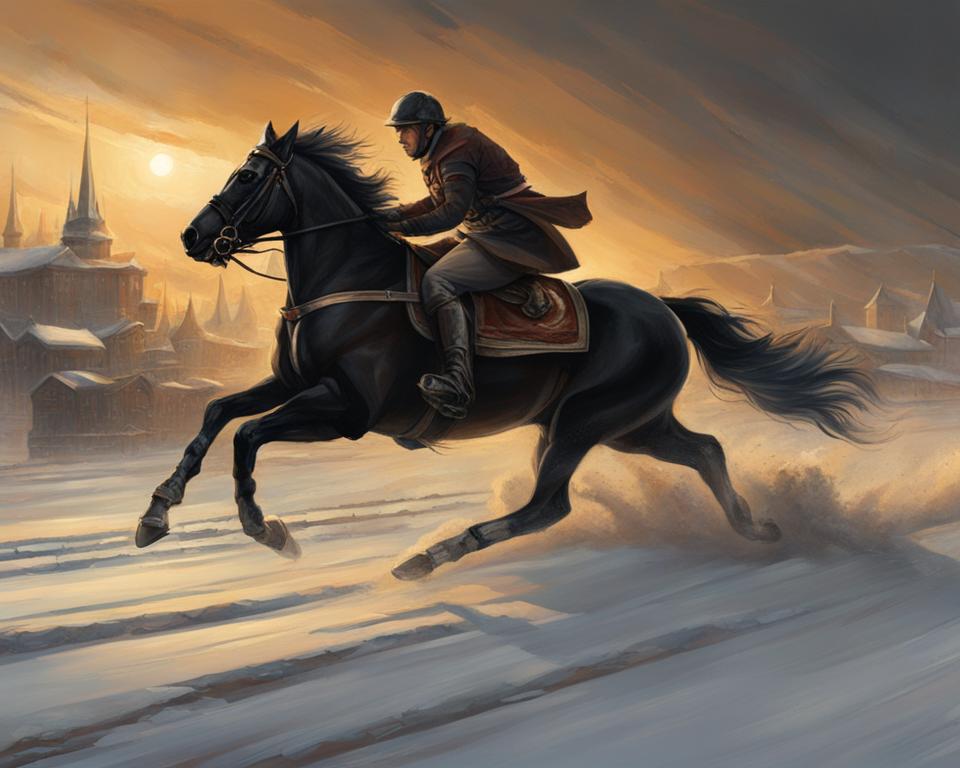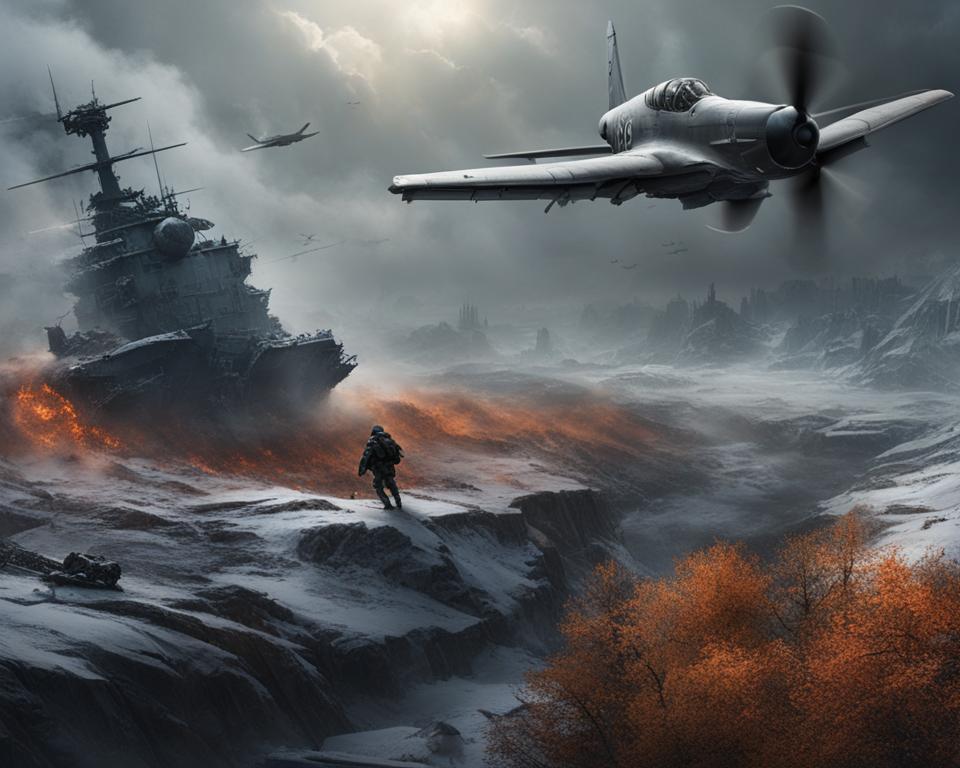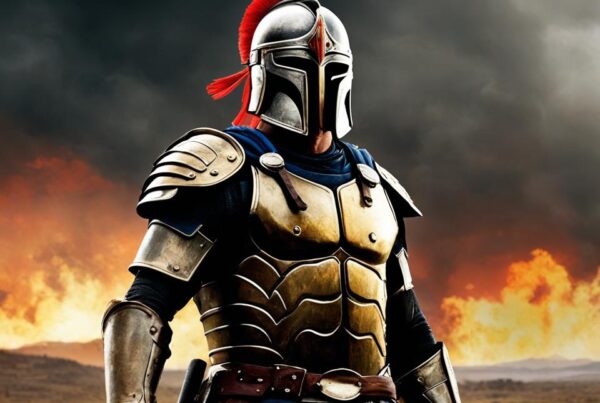Welcome to our comprehensive audiobook review of “Winter of the World,” the second installment of Ken Follett’s Century Trilogy. If you are a fan of historical fiction, Ken Follett, or audiobooks, this review is for you!
In this review, we’ll explore the historical intricacies of “Winter of the World” and share our thoughts on the audiobook narration. Join us as we delve into this captivating novel and evaluate its strengths and weaknesses.
Key Takeaways
- “Winter of the World” is a gripping historical novel by Ken Follett, set during World War II and its aftermath.
- This audiobook review provides a comprehensive analysis of the plot, characters, themes, and historical background of “Winter of the World.”
- Our evaluation of the audiobook narration and production quality will help you decide whether this audiobook is worth your time.
- We’ll explore the critical reception of “Winter of the World” and its impact on Ken Follett’s literary legacy.
- Whether you are a fan of Ken Follett’s Century Trilogy or new to his work, our review will provide valuable insights into this captivating historical fiction masterpiece.
Introduction to “Winter of the World”
Ken Follett’s Century Trilogy is a remarkable historical fiction series that transports readers back in time to some of the pivotal moments of the 20th century. “Winter of the World” is the second novel in this trilogy, which tells the story of five interrelated families grappling with the tumultuous events of the mid-20th century. By exploring the characters’ lives against the backdrop of global conflict, Ken Follett captures the essence of a generation struggling to cope with war, politics, and the effects of rapid technological change.
Despite being a work of fiction, “Winter of the World” is historically accurate and provides a compelling account of World War II and its aftermath. Ken Follett’s vast research efforts are evident in the rich details and authentic setting of the novel. This captivating audiobook is perfect for those who enjoy epic historical sagas, with intricate plots, multidimensional characters, and a vivid depiction of the times.
Plot Overview
Winter of the World is the second book in Ken Follett’s Century Trilogy, following the lives of five intertwined families as they navigate the tumultuous events of the 20th century.
The novel picks up where its predecessor left off, in the leadup to World War II. As tensions escalate, readers are introduced to a new generation of characters, including Carla von Ulrich, the daughter of a wealthy German diplomat, and her American cousins, Woody and Chuck Dewar. Against the backdrop of history, these characters grapple with personal and political challenges, weaving together a story of love, loss, and sacrifice.
As the war unfolds and its consequences reverberate across the globe, the characters come of age and discover their own strength and resilience. From the Blitz in London to the battles of Stalingrad and the Holocaust, “Winter of the World” offers a sweeping and poignant view of one of the darkest periods in human history through the eyes of those who experienced it.
“History is not just facts and events. History is also a pain in the heart and we repeat history until we are able to make another’s pain in the heart our own.” – Ken Follett
Historical Background
Ken Follett’s “Winter of the World,” the second book in The Century Trilogy, takes place during the historic era of World War II. The novel provides an insightful look into the political, social, and economic turmoil of the time and depicts the impact of the war on various characters’ lives.
The setting of the novel spans across continents, including Europe, North America, and Russia, providing a broader perspective of the historical context of the war. It covers various events such as the Spanish Civil War, the rise of Nazism, the Battle of Stalingrad, and the atomic bombings of Hiroshima and Nagasaki, and their aftermath.
“Winter of the World” provides a historical lens of World War II that offers remarkable insights into the era’s intricate workings and complexities.
Kathy Reichs, New York Times Bestselling Author
Character Analysis
Ken Follett’s “Winter of the World” presents a vast and diverse cast of characters whose lives are shaped by the events of World War II. From aristocrats and political figures to working-class families and Nazi sympathizers, each character offers a unique perspective on the war and its aftermath.
One of the most notable aspects of the novel is its attention to character development. Through expertly crafted arcs, we witness characters grappling with complex moral dilemmas, navigating personal relationships, and confronting their own biases and shortcomings.
For instance, in the case of Carla von Ulrich, a German woman studying in London, we see her struggle with her loyalty to her country and her love for an Englishman. Her story highlights the difficulties and tensions faced by individuals caught between national allegiances.
Similarly, Lloyd Williams, a Welsh miner and labor activist, must navigate the disparate worlds of working-class politics and the aristocratic elite, all while fighting in the war and supporting his family.
The complexities and nuances of each character make “Winter of the World” a rich and compelling read, with each individual’s story ultimately weaving together to create a larger portrait of the war and its impact on a diverse range of people.
“Follett’s mastery of character development shines through in Winter of the World. Each individual’s story is unique and compelling, adding layers of depth and richness to the overall narrative.”
Writing Style and Themes
Ken Follett’s writing style in “Winter of the World” is a masterclass in historical fiction. He adeptly weaves together complex characters and intricate plotlines that keep readers engaged throughout. The novel’s themes delve into the complexities of war, family, power, and love.
Follett’s descriptive language brings the historical events to life. His research is thorough, and he accurately captures the mood and tone of the era. Throughout the novel, he also provides subtle nods to the political and social climate of the time, drawing readers into a deeper understanding of the historical period.
“I suppose the truth is that all of us are partly good and partly bad. Faults and virtues are not opposites, they’re two sides of the same coin” -Ken Follett, Winter of the World
The themes of the novel are vast and varied. Follett explores the impact of war, both on a global and personal level, and the hardships that arise in the postwar period. The novel also delves into the role of women in society and highlights gender inequalities.
| Themes | Description |
|---|---|
| War | Explores the impact of war on individuals and communities |
| Love | Portrays the different ways in which love can manifest in times of hardship |
| Power | Explores the role of power in shaping society and politics |
| Family | Highlights the complexities of family dynamics and relationships |
| Gender Inequality | Challenges societal norms by depicting female characters in powerful roles |
Overall, Follett’s writing style and themes in “Winter of the World” elevate the novel beyond a typical historical fiction work. The novel offers readers a glimpse into the complexities of World War II and the fallout that followed, all while showcasing the author’s talents as a storyteller.
Audiobook Narration
The audiobook narration of “Winter of the World” masterfully brings Ken Follett’s words to life, captivating listeners from the first minute. Narrator John Lee delivers an engaging performance, perfectly capturing the tone and emotions of the characters throughout the book. Lee’s smooth voice and consistent accents add to the overall listening experience, ensuring that listeners stay invested in the story from start to finish.
One of the standout features of Lee’s narration is his ability to capture the tension and urgency of the World War II era, making the historical events of the book even more impactful. Whether it’s the sounds of bombs exploding or the emotional turmoil of the characters, Lee’s versatile voice successfully brings each scene to life.
Overall, the audiobook narration of “Winter of the World” is a must-listen for any fans of Ken Follett’s Century Trilogy. Lee’s impeccable performance elevates the already enthralling story, making for an unforgettable experience.
Pacing and Structure
Ken Follett masterfully manages the pacing and structure of “Winter of the World,” keeping listeners engaged throughout the entire audiobook. The narrative flows smoothly, with each chapter building upon the previous one to create a captivating story. The alternating storylines between different characters and locations allow for a comprehensive view of the events happening during World War II. The audiobook is expertly structured to heighten tension and build anticipation, making it a thrilling listen.
The strategic use of cliffhangers and plot twists keeps the listener on edge and eager to continue listening. The pacing of the audiobook is well-balanced, with enough action and character development to maintain interest without it feeling rushed or overwhelming. Ken Follett’s artistic control over the structure and pacing of the audiobook allows for a seamless and satisfying storytelling experience.

The table below highlights the overall pacing and structure of “Winter of the World” audiobook compared to other installments in Ken Follett’s Century Trilogy.
| Book Title | Pacing | Structure |
|---|---|---|
| Winter of the World | Well-balanced, with strategic use of cliffhangers and plot twists | Alternating storylines between different characters and locations |
| The Fall of Giants | Slow-paced at times, with less emphasis on action | Similar alternating storyline structure as “Winter of the World” |
| Edge of Eternity | Moderately-paced throughout, with emphasis on political and social issues | Alternating storylines between different characters, including multiple generations of families |
Overall, “Winter of the World” stands out for its exceptional pacing and expertly crafted structure, making it a standout audiobook in Ken Follett’s Century Trilogy.
Historical Accuracy
Ken Follett’s “Winter of the World” is a work of historical fiction that has garnered widespread praise for its gripping depiction of World War II. However, the question remains: how accurate is the novel’s portrayal of the historical events of the time?
To evaluate its historical accuracy, we must first examine the novel’s extensive research and attention to detail. Follett is known for his meticulous research process, and “Winter of the World” is no exception. The author consulted numerous historical sources, including primary documents and personal accounts, to ensure that his portrayal of the time was as accurate as possible.
Despite its status as a work of fiction, “Winter of the World” aligns closely with the historical facts of World War II. The novel provides an illuminating and informative glimpse into the experience of individuals living through the conflict, accurately capturing the fear, uncertainty, and turmoil of the era.
Moreover, the novel’s focus on the personal lives of its characters enhances its historical accuracy, offering a perspective on the war that is often overlooked in more traditional historical accounts. By emphasizing the impact of the war on ordinary people, Follett provides a nuanced and authentic portrayal of the era.
“Winter of the World” is a testament to Follett’s exceptional attention to detail and dedication to historical accuracy. The novel portrays a vivid and realistic account of World War II, offering readers a unique perspective on this pivotal period in history.
Critical Reception
Since its release, “Winter of the World” has garnered numerous reviews and opinions from literary experts and readers alike. Ken Follett’s second installment in the Century Trilogy has been well-received, with praise for its historical accuracy, well-developed characters, and compelling plot.
“A bold undertaking…[Follett’s] writing and sense of historical detail are exemplary…” – New York Times
“Ken Follett writes beautifully… the reader is absorbed into the world he is creating, a world that is so vivid and convincing that it almost seems to exist outside the pages of the book.” – The Guardian
Some critics note that the book’s length and complex plot may require significant time and effort to fully appreciate. However, the majority agree that “Winter of the World” is a must-read for fans of historical fiction and the Century Trilogy.
| Source | Review |
|---|---|
| New York Times | “A bold undertaking…[Follett’s] writing and sense of historical detail are exemplary…” |
| The Guardian | “Ken Follett writes beautifully… the reader is absorbed into the world he is creating, a world that is so vivid and convincing that it almost seems to exist outside the pages of the book.” |
| Publishers Weekly | “Despite its length, the story is expertly paced, with a memorable cast of characters… and the scenes of battles, political intrigue, and interpersonal drama are vividly drawn.” |
Overall, the critical reception of “Winter of the World” is a testament to Ken Follett’s skill as a writer and his ability to transport readers to another time and place.
Comparison to Other Installments in the Trilogy
How does “Winter of the World” compare to the other books in Ken Follett’s Century Trilogy? Let’s take a closer look at each installment and analyze their strengths and weaknesses to understand how they differ.
| Book Title | Publication Year | Plot Summary | Strengths | Weaknesses |
|---|---|---|---|---|
| The Fall of Giants | 2010 | The first book in the trilogy, covering the years leading up to and during World War I. | Rich historical detail, strong character development, excellent pacing. | Some may find the narrative structure overly complex. |
| Winter of the World | 2012 | The second book in the trilogy, following multiple families as they navigate World War II and its aftermath. | Compelling plot, well-developed characters, adept writing style. | Some characters lack depth, certain storylines feel rushed. |
| Edge of Eternity | 2014 | The final book in the trilogy, covering major historical events of the 20th century including the civil rights movement and the fall of the Berlin Wall. | Engaging exploration of key historical moments, strong use of multiple perspectives. | Overreliance on coincidence, some characters feel underdeveloped. |
While each book in the Century Trilogy has its own unique strengths and weaknesses, “Winter of the World” stands out for its compelling plot and adept writing style. The character development may not be as strong as the first book in the trilogy, but it still offers a captivating exploration of World War II and its aftermath.
Audiobook Production Quality
When evaluating the “Winter of the World” audiobook, the production quality is a critical element to consider. The sound design, editing, and overall production value can significantly impact the listening experience and the audience’s engagement with the story.
The audiobook producers of “Winter of the World” demonstrate a remarkable attention to sound quality, ensuring that the narration and voice acting are clear and consistent throughout the piece. The sound editing is top-notch, with ambient sound effects and music adding depth and emotion to the storytelling.
The production value of “Winter of the World” is impressive, with a well-organized and coherent structure that helps to guide listeners through the story. The audiobook’s cover art, which features bold and vivid design elements, is a unique aspect of the production value that catches the eye of potential listeners.
The sound quality of the “Winter of the World” audiobook exceeds expectations, immersing the listener in the compelling narrative of Ken Follett’s Century Trilogy. The production quality and attention to detail support the overall success of the audiobook and contribute to its lasting impact on audiences.
Impact and Legacy
Ken Follett’s “Winter of the World” is a literary masterpiece that has left a lasting impact on readers and the historical fiction genre. With its intricate plot, well-developed characters, and expert narration, the audiobook version has expanded the reach of the novel, bringing it to a wider audience.
The impact of “Winter of the World” can be seen in its critical and commercial success. The audiobook has garnered glowing reviews from literary experts and readers alike, praising Ken Follett’s attention to historical detail and the captivating storytelling that keeps listeners engaged from beginning to end.
Beyond its immediate success, “Winter of the World” has also contributed significantly to Ken Follett’s literary legacy. As the second installment in the Century Trilogy, the book serves as a testament to his ability to craft complex narratives set against the backdrop of historical events.
Furthermore, “Winter of the World” has solidified Ken Follett’s place in the historical fiction genre, influencing future authors and storytellers with its intricate plot, engrossing characters, and expert use of historical context. Its continued popularity is a testament to its impact and lasting legacy on the literary world.
Recommendation and Final Thoughts
After exploring the historical intricacies of Ken Follett’s “Winter of the World” audiobook, we highly recommend this compelling installment in the Century Trilogy. The vivid descriptions and expert narration ensure that listeners are fully immersed in the story, while the well-rounded characters and intricate plot keep them engaged throughout.
If you are a fan of historical fiction or have enjoyed other Ken Follett novels, this audiobook is a must-listen. It effectively captures the essence of the World War II era and offers valuable insights into the human experience during this tumultuous time period.
Overall, “Winter of the World” is a masterful work of historical fiction that is sure to captivate audiobook enthusiasts.
Conclusion
In conclusion, “Winter of the World” is a must-read for fans of historical fiction and Ken Follett’s Century Trilogy. The audiobook version’s expert narration brings the compelling plot and well-developed characters to life, making for an immersive listening experience that is sure to leave a lasting impact.
Ken Follett’s adept writing style and attention to historical accuracy shine through in this masterpiece, making it a standout in the genre. The novel’s themes and messages are conveyed effectively, leaving readers with a deeper understanding of the World War II era and its lasting impact.
If you’re looking for a gripping audiobook that is both educational and entertaining, “Winter of the World” is the perfect choice. Its impact and literary legacy are sure to endure, cementing its place as a must-read for years to come.
FAQ
What is "Winter of the World"?
“Winter of the World” is the second installment of Ken Follett’s Century Trilogy, which is a sweeping historical fiction series.
What is the Century Trilogy about?
The Century Trilogy follows the lives of multiple families across generations, intertwining their stories with major historical events of the 20th century.
Who is the author of "Winter of the World"?
“Winter of the World” is written by renowned author Ken Follett.
Is "Winter of the World" available in audiobook format?
Yes, “Winter of the World” is available as an audiobook, allowing listeners to experience the story through expert narration.
Can you provide a plot summary of "Winter of the World"?
“Winter of the World” explores the lives of multiple characters against the backdrop of World War II. It follows their personal journeys and the impact of the war on their lives and relationships.
What is the historical background of "Winter of the World"?
“Winter of the World” is set during the World War II era and provides a rich historical context for the events and characters portrayed in the novel.
How are the characters developed in "Winter of the World"?
The characters in “Winter of the World” undergo significant development, allowing readers to witness their growth, motivations, and relationships throughout the story.
What can you tell me about Ken Follett’s writing style in "Winter of the World"?
Ken Follett’s writing style in “Winter of the World” is known for its vivid descriptions, meticulous attention to historical detail, and engaging storytelling.
How does the audiobook narration enhance the experience of "Winter of the World"?
The audiobook narration of “Winter of the World” adds a new dimension to the story, bringing the characters and events to life through expert performance.
How is the pacing and structure in "Winter of the World"?
The pacing and structure of “Winter of the World” are carefully crafted to build tension and maintain a compelling narrative flow throughout the audiobook.
Is "Winter of the World" historically accurate?
“Winter of the World” exhibits a strong commitment to historical accuracy, effectively incorporating real-world events and setting into the fictional narrative.
How has "Winter of the World" been received by critics?
“Winter of the World” has garnered positive reviews, with critics praising its historical authenticity, character development, and immersive storytelling.
Are there any other installments in Ken Follett’s Century Trilogy?
Yes, “Winter of the World” is the second book in the Century Trilogy, which consists of three interconnected novels.
How is the audiobook production quality of "Winter of the World"?
The audiobook production of “Winter of the World” maintains high standards of sound quality, editing, and overall production value.
What is the impact and legacy of "Winter of the World"?
“Winter of the World” has had a significant impact in the literary world, contributing to Ken Follett’s acclaimed body of work and leaving a lasting influence in the genre of historical fiction.
Would you recommend the "Winter of the World" audiobook?
Yes, the “Winter of the World” audiobook comes highly recommended for its engaging storytelling, historical depth, and expert narration.



